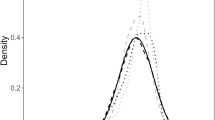Abstract
The intercorrelations of thirty-seven variables, including the Minnesota battery of “mechanical ability” tests, the seven MacQuarrie tests of “mechanical ability,” O'Connor's Wiggly blocks, and the Stenquist picture-matching test, were analyzed by Thurstone's centroid method. Five factors, Perceptual, Verbal, Youth, Manual Agility, and Spatial, were taken out. Factors prominent in so-called mechanical ability tests are the Spatial and Perceptual ones with Mac-Quarrie's dotting test significantly high in the Manual Agility factor. Each of the factors can be measured with group pencil-and-paper tests.
Similar content being viewed by others
References
Bronner, A. F.,et al. A manual of individual mental tests and testing. Boston: Little, Brown and Co., 1927.
Crockett, A. C. Measure of manual ability.J. appl. Psychol., 1930,14, 414–424.
Guilford, J. P. Psychometric methods. New York: McGraw-Hill Book Co., 1936.
Harrell, W. The validity of certain mechanical ability tests for selecting cotton mill machine fixers.J. soc. Psychol, 1937, 8, 279–282.
MacQuarrie, T. W. A mechanical ability test.J. person. Res., 1927,5, 329–337.
O'Connor, J. Born that way. Baltimore: Williams and Wilkins, 1928.
Paterson, D. G.,et al. Minnesota mechanical ability tests. Minneapolis: Univ. Minnesota Press, 1930.
Stenquist, J. L. Stenquist mechanical aptitude tests. Yonkers, New York: World Book Co., 1921.
Stoelting, C. H., and Co. Catalog of psychological and physiological apparatus and supplies. Chicago.
Thurstone, L. L. The vectors of mind. Chicago: Univ. Chicago Press, 1935.
Thurstone, L. L. Primary mental abilities. Psychometric monographs, No. 1. Chicago: Univ. Chicago Press, 1938.
Thurstone, L. L. A new rotational method in factor analysis. Psychometrika, 1938,3, 199–218.
Thurstone, L. L. Manual of instructions. Tests for primary mental abilities. Washington: Amer. Council Educ., 1938.
Tucker, L. R. A method for finding the inverse of a matrix. Psychometrika, 1938,3, 189–197.
Whitman, E. C. A brief test series for manual dexterity.J. educ. Psychol., 1925,16, 118–123.
Author information
Authors and Affiliations
Additional information
Acknowledgment is gratefully made to the State Engineering Experiment Station at the Georgia School of Technology for sponsoring and financially supporting the studies; to the Graduate Research Committee of the University of Illinois for providing funds for the purchase of tests and the tabulation of data; and to Dr. E. L. Welker of the University of Illinois Mathematics Department for assistance with statistical problems.
Rights and permissions
About this article
Cite this article
Harrell, W. A factor analysis of mechanical ability tests. Psychometrika 5, 17–33 (1940). https://doi.org/10.1007/BF02288557
Issue Date:
DOI: https://doi.org/10.1007/BF02288557




